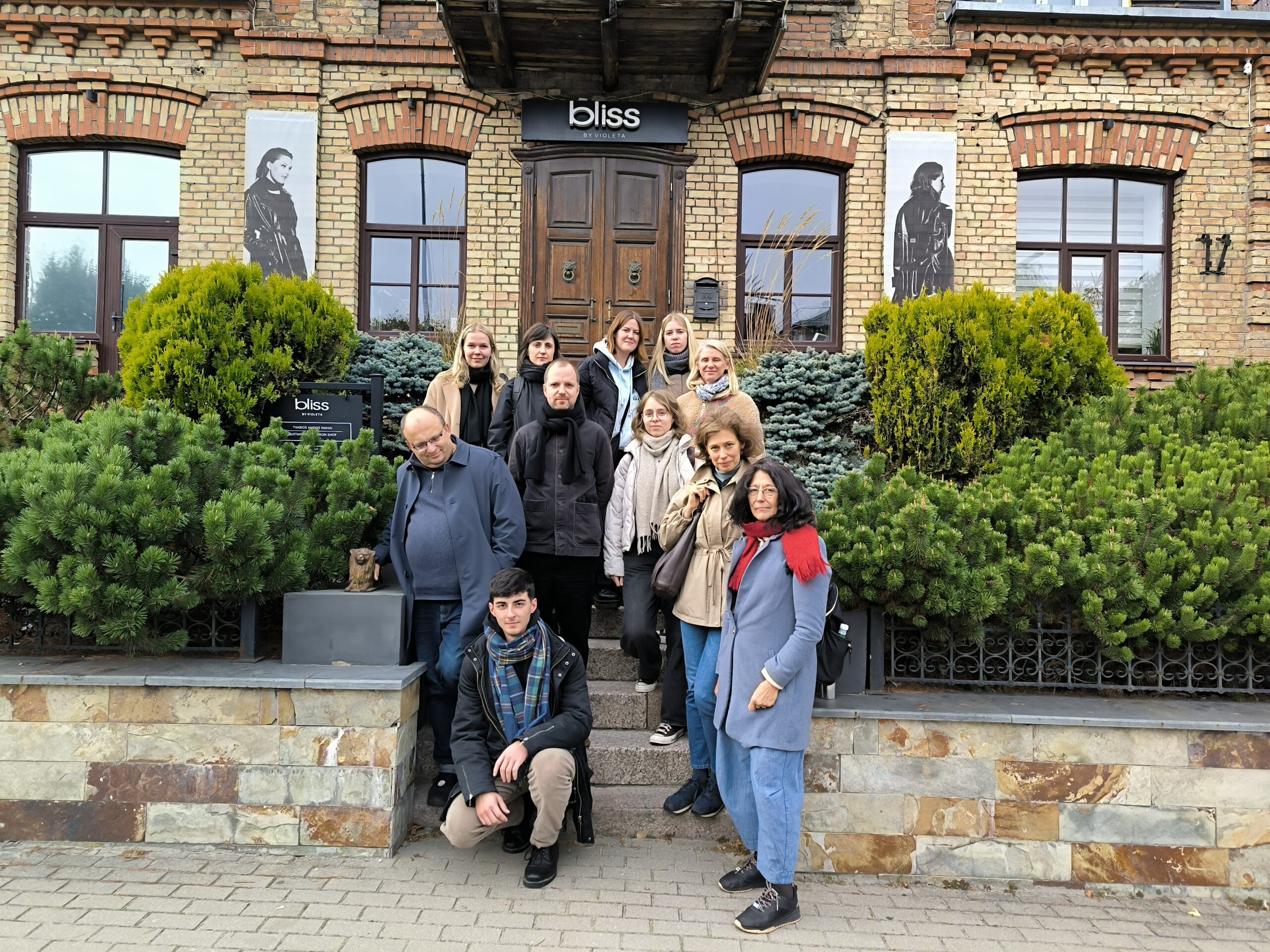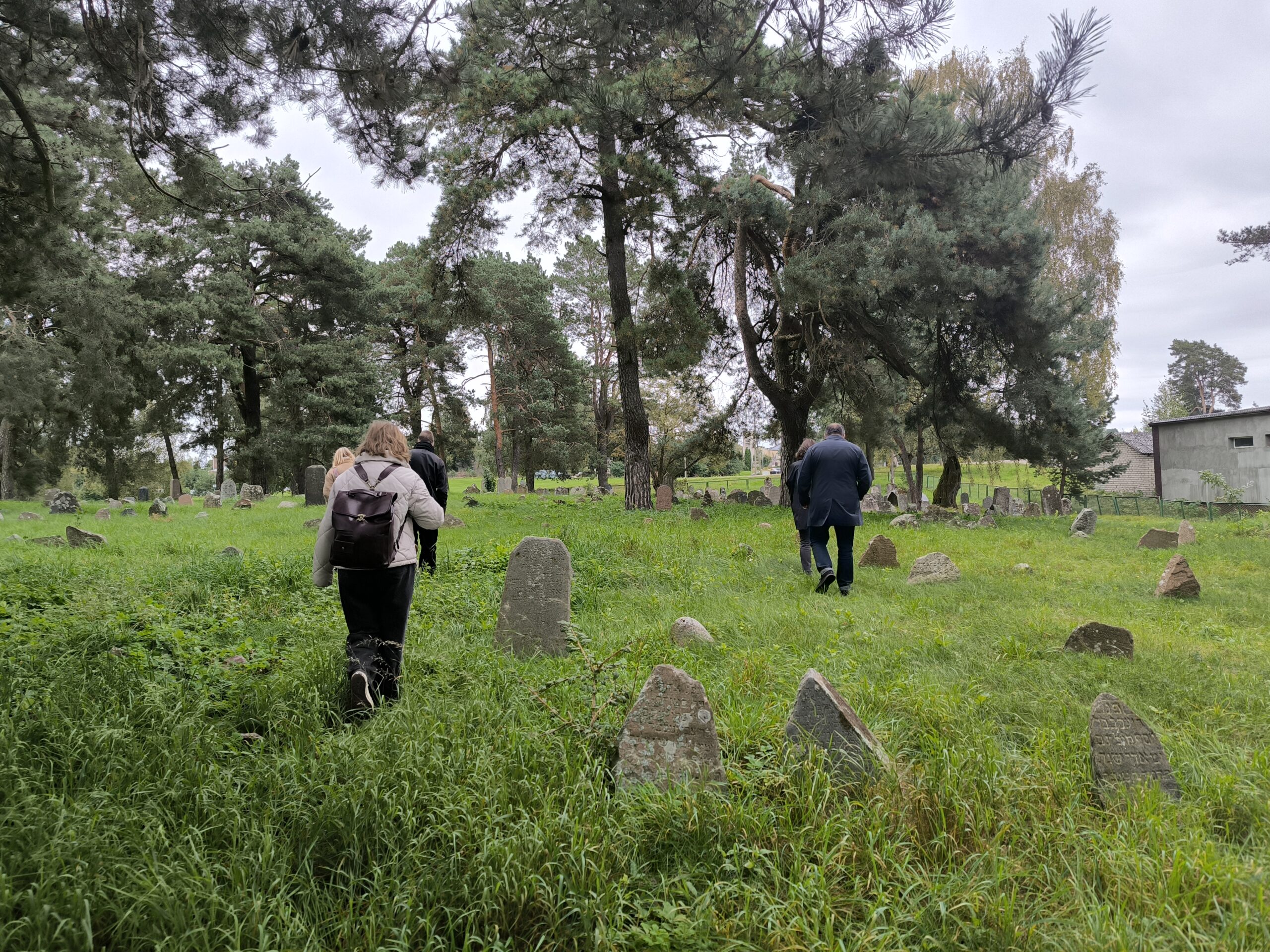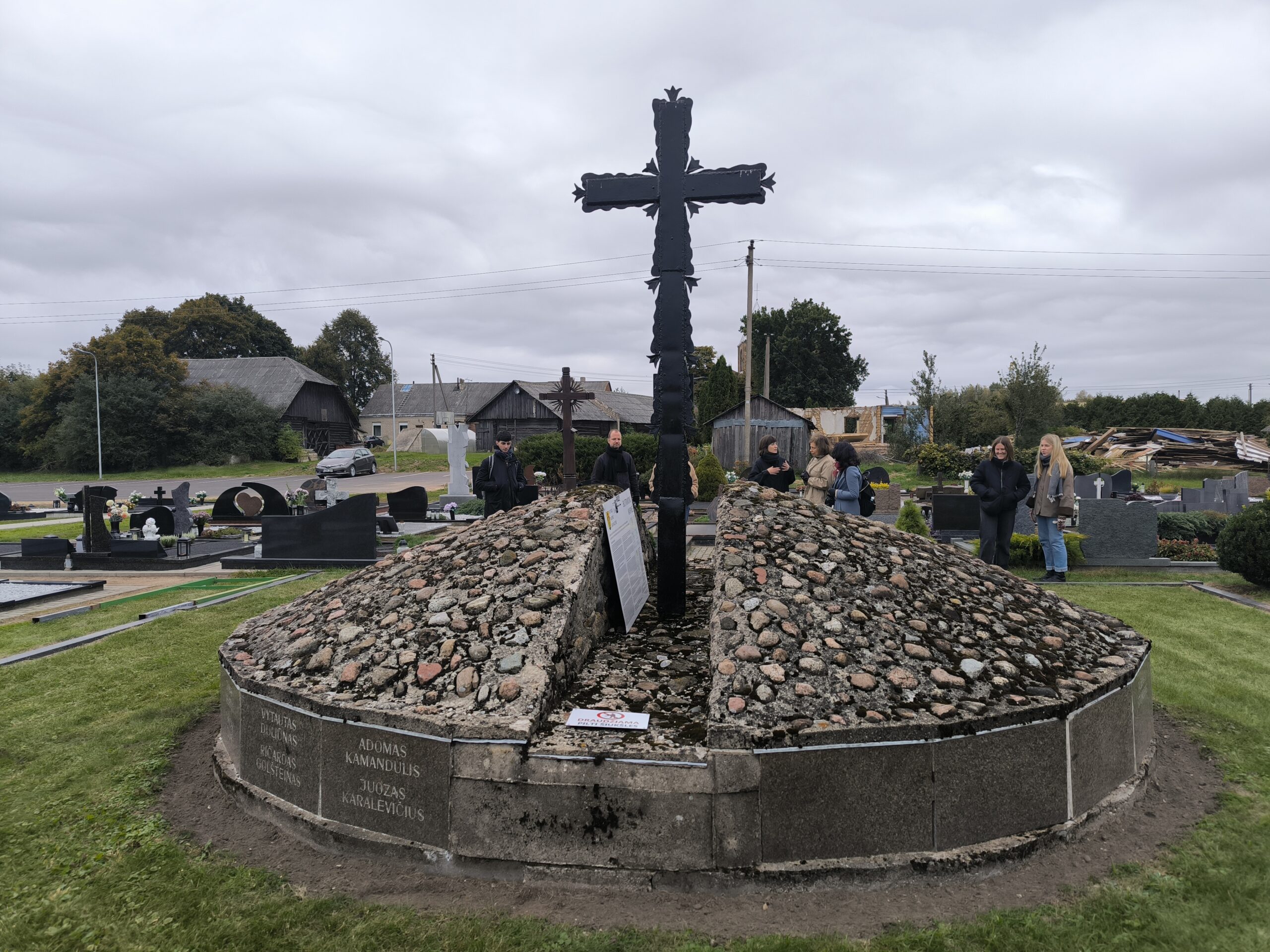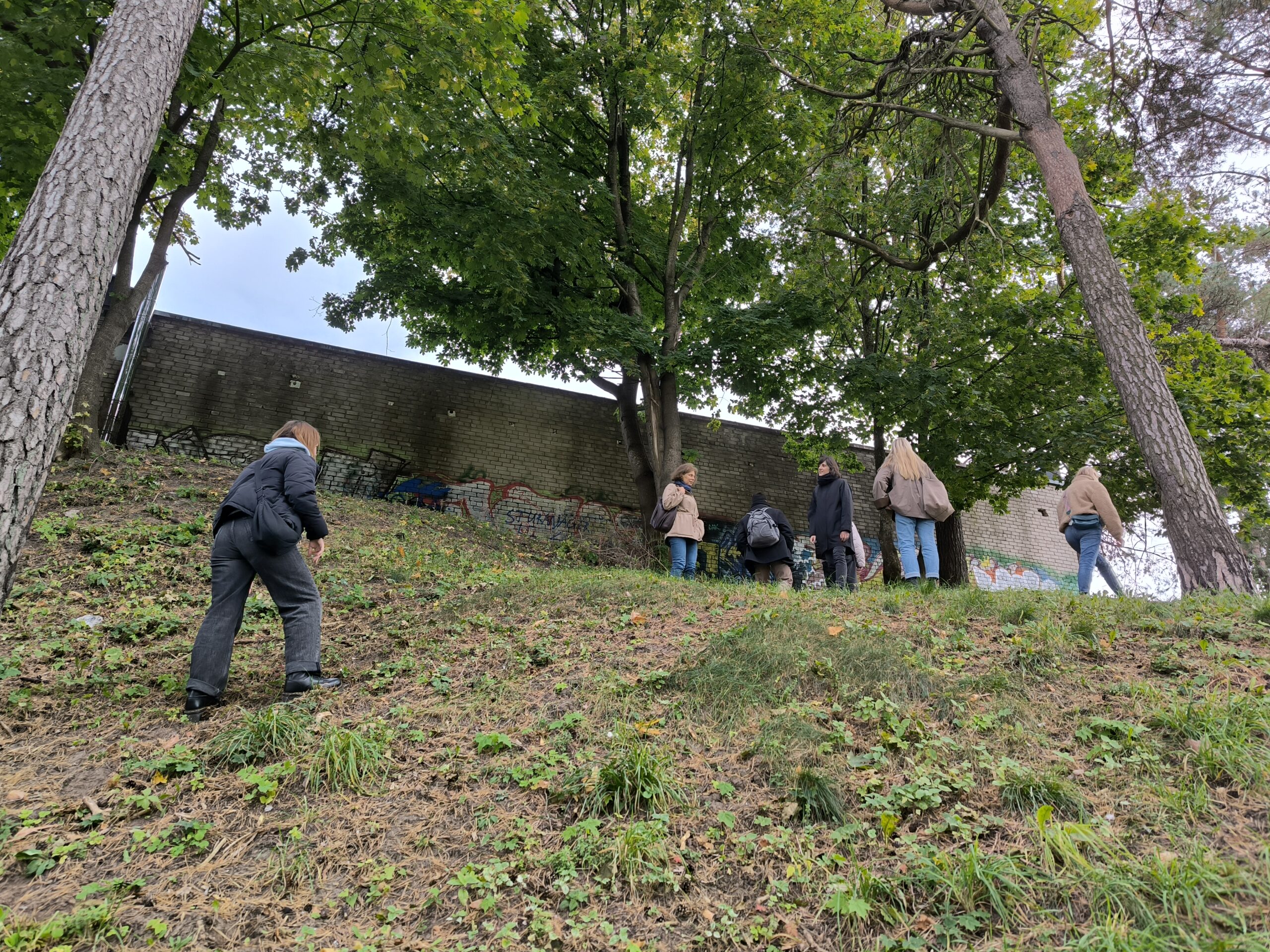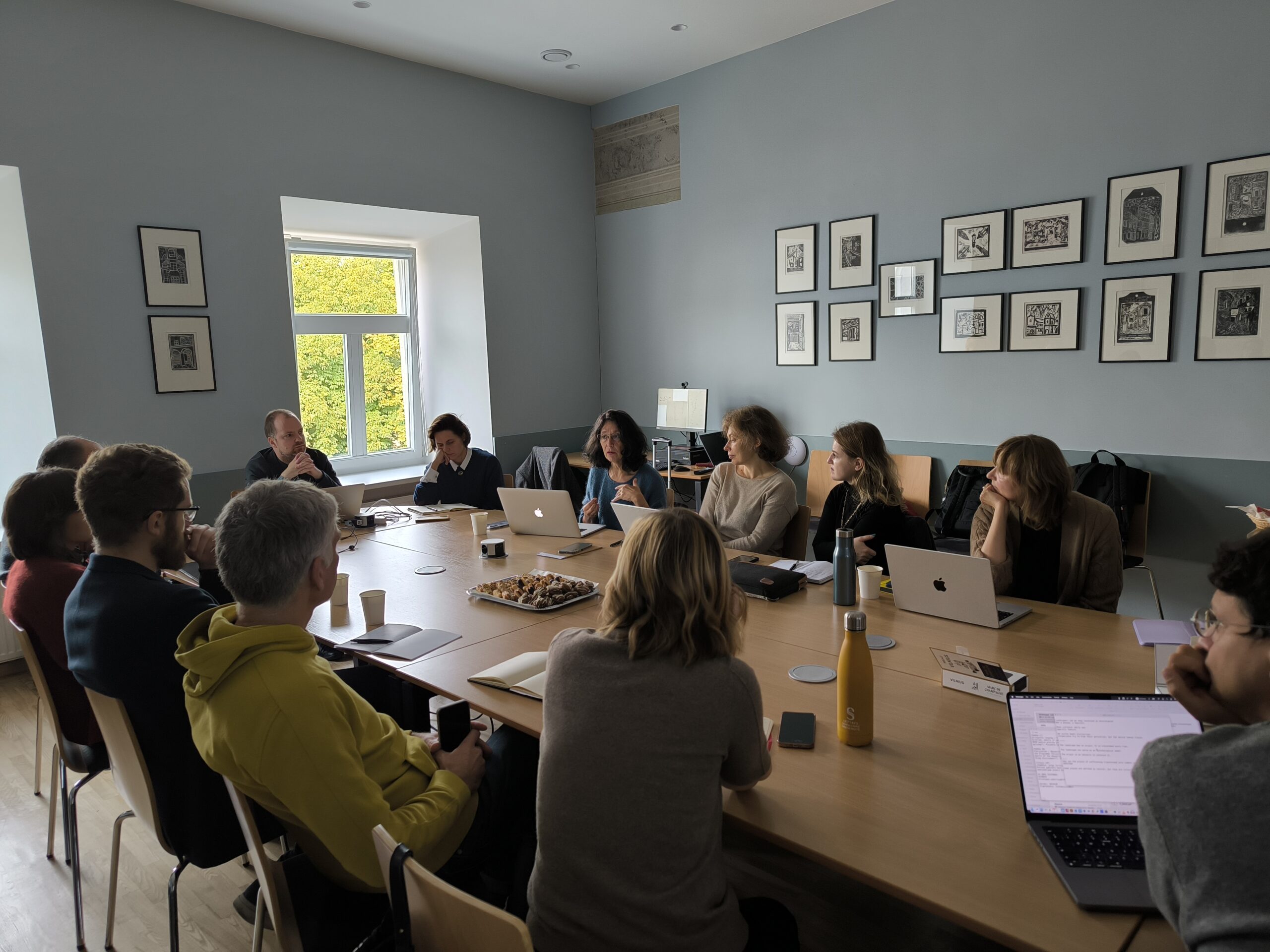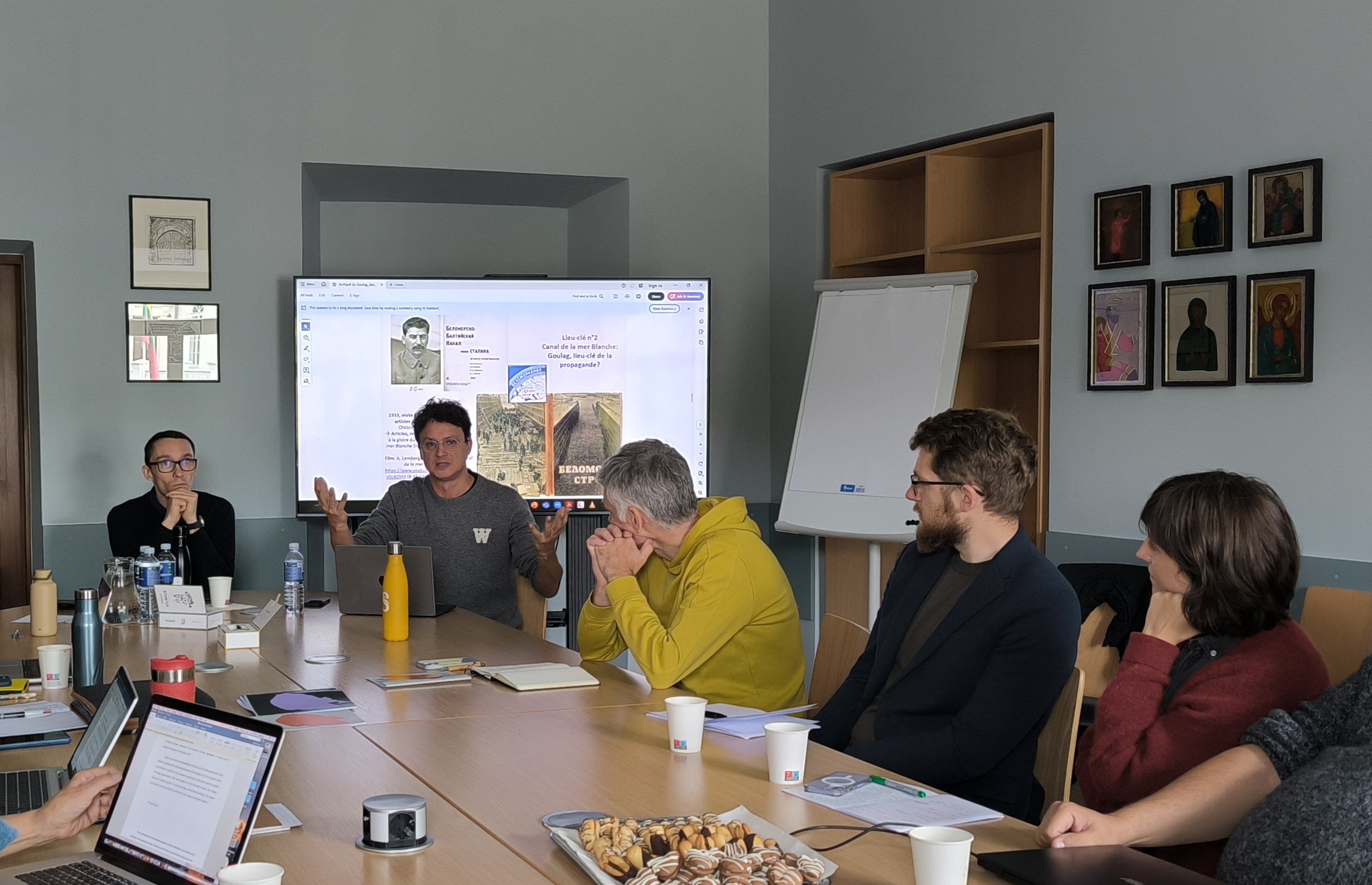October at PAScapes began with a visit from two professors from France – Luba Jurgenson (Sorbonne University) and Emilia Koustova (University of Strasbourg). During their visit, the guests and PAScapes researchers devoted most of their time to discussing the conceptualization, methodology, perspectives, and in situ exploration of the landscapes of violence.
The visit began on Friday, October 3, with a public lecture by Professor Luba Jurgenson titled “Landscape as Witness of Violence: Memory of the Living”. In front of a packed audience of students from the Faculties of History, Philology, and Philosophy, she introduced the concept of landscapes of violence (still little known in Lithuania), discussed the challenges of defining landscape itself, and shared insights from her previous research.
Saturday was dedicated to a full-day field trip to Butrimonys and Alytus, aimed at seeing sites of violence firsthand – to experience them, and to gain a deeper understanding of the issues of memory and forgetting, as well as the specific Lithuanian context, shaped by the historical shifts through three occupations – the first Soviet (1940–1941), the Nazi (1941–1944), and the second Soviet (1944–1990) regimes, which took control of the processes of commemorating and interpreting the wartime mass killings and the Holocaust.
During the field trip, the expedition visited Butrimonys’ central square – a space symbolizing the intertwined and chaotic memory of wartime and postwar events – as well as the old Jewish cemetery, the memorial to partisans, and a memorial marking a Jewish massacre site. A similar itinerary awaited in Alytus, where the researchers visited the old synagogue, now functioning as a cultural center, the destroyed old Jewish cemetery, and the Vidzgiris Forest, which left a particularly strong impression on everyone. In this forest, located near the city, the Jews of Alytus were once murdered. The first obelisk was erected here during the Soviet period, and today the six-hectare area dedicated to their memory – though filled with monuments – is often perceived by locals not as a site of tragedy, but simply as a park, a place for leisurely walks.
A seminar titled “Geography and Violence: What Defines an Authoritarian Landscape?” was held on Monday to reflect on the experiences of the field trip and to discuss the ongoing research. The seminar aimed to consider how authoritarian regimes, which almost always rely on control, repression, and violence, shape the relationship between violence and landscape, and what the notion of landscapes of violence can reveal about authoritarian space.
Prof. Koustova studies mass deportations and their landscapes, focusing on how violence, memory, and space intertwine. According to her, when speaking about mass deportations, landscape is a subject, an object, and a means through which Soviet repression becomes visible. Both natural and human-made environments were deeply affected by these repressions, particularly where they intersected with collectivization.
The natural environment itself was closely integrated into how Soviet authorities conceived and implemented their repressive policies. Archival materials – including maps from Ukraine and Lithuania – reveal what she calls a form of repressive cartography, showing routes of deportations, planned operations, and the logistical organization of the process.
As Koustova notes, when we move to the question of exile, we see that landscapes – whether natural, human-made, or hybrid – were also matters of planning. The locations of deportees’ settlements were deliberately chosen: their distance from cities, rivers, and infrastructure was part of the logic of control. Space itself is vividly present in all forms of memory production – in deportees’ photographs and other visual materials – yet this spatial dimension remains a significant but still underexplored aspect when discussing the long-term memory of deportation.
After 1953, when many deportees were released, new relationships with the environment began to take shape. Some remained in places of exile, forming new attachments to the surrounding landscapes; others returned but continued to revisit these sites (a phenomenon often linked to solastalgia). From this perspective, Koustova is interested in post-violence landscapes – environments still marked by trauma, but not yet post-authoritarian.
Prof. Jurgenson began by reflecting on the status of landscapes marked by violence, questioning whether they could be considered heterotopias. Instead, she proposed to understand them through their everyday use – as places that are at once ordinary and extraordinary, carrying a cultural and symbolic layer linked both to daily life and to violent histories. Jurgenson noted that this ambiguity also mirrors the logic of mass violence itself, since perpetrators sought to conceal their actions, even though massacres and deportations often took place in close proximity to local communities.
Jurgenson then discussed another methodological aspect of her approach. Drawing on the broader definition of landscape proposed by the Landscape Research Association, she emphasized the need for a figure of mediation to reveal the relationship between place, memory, and narration. Within this framework, she distinguished two important types of landscapes – “places of no memory” and “places with a blasphemous trace”.
The Professor also presented her ongoing research on how sites of suffering can be transformed into a “common good”. She asked how places marked by pain, trauma, and dark history can be understood in relation to the idea of good, drawing on UNESCO’s debates on heritage. Many such landscapes are now listed as heritage sites, yet their violent pasts are often omitted. For example, the Solovki Islands, once home to the first Gulag, appear on UNESCO’s World Heritage list with almost no reference to this history – revealing how the component of violence is erased from official narratives.
Jurgenson noted that the definition of heritage itself has evolved: once seen as strictly natural, it now includes cultural and mixed landscapes. However, some sites – such as Białowieża Forest, where partisans and Jews were killed – are still presented as purely natural spaces, detached from their historical and political layers. Finally, she suggested that the tendency to present landscapes primarily as heritage might reflect contemporary ecological concerns, which privilege environmental value while obscuring political and historical dimensions. As a result, the status of landscape remains unstable, continually shifting under the influence of ideological frameworks and changing perceptions of what is considered worth preserving.
During the seminar, moderated by historian Assoc. Prof. Tomas Vaiseta, PAScapes philosophers Assoc. Prof. Vaiva Daraškevičiūtė and Prof. Kristupas Sabolius presented their research and shared their ideas in greater depth. Assoc. Prof. Daraškevičiūtė’s research focused on the aesthetics of landscape in the context of the Anthropocene. In her view, the theme of the seminar was related to her work through two key aspects – the notion of authority and the experience of the uncanny – which she further developed in her presentation. Meanwhile, Prof. Sabolius presented the research field and challenges of the PAScapes philosophical project, focusing on ecosocial ideas that seek to unite ecology and society. He admitted that he did not have a clear answer to what a post-authoritarian landscape truly is, which led him to the question of imagination. He noted that modernity was shaped by an imaginary separating humans from nature and referred to theories of the technical imaginary – the idea that societies design their futures through technologies, infrastructures, and institutions. Such imaginaries, he suggested, shape modern life by embedding visions of desirable futures into material forms. Sabolius raised the question of whether the idea of landscape, with all its complexity, could serve as a critical device – a conceptual position that addresses the colonial and authoritarian dimensions of socio-technical imaginaries.
We extend our sincere thanks to our guests and all participants for an engaging and thought-provoking time together. We are also pleased to announce that Professor Emilia Koustova will continue her work with PAScapes for another month, delivering lectures within the Soviet Studies and Sovietology module for third- and fourth-year students at the Faculty of History.
Written by Agnė Kereišiūtė

